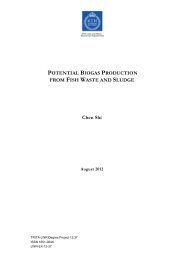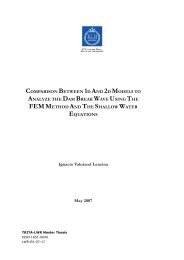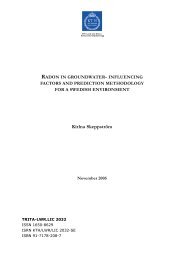water sources, infrastructure, space and the dynamics of ...
water sources, infrastructure, space and the dynamics of ...
water sources, infrastructure, space and the dynamics of ...
Create successful ePaper yourself
Turn your PDF publications into a flip-book with our unique Google optimized e-Paper software.
Mat<strong>the</strong>w Biniyam KursahTRITA LWR Master Thesisdistances to <strong>water</strong>courses, road networks, <strong>the</strong> type <strong>of</strong> l<strong>and</strong> cover <strong>and</strong>elevation on one h<strong>and</strong> <strong>and</strong> <strong>the</strong> environmental diseases on <strong>the</strong> o<strong>the</strong>r.Therefore, <strong>the</strong> stated hypo<strong>the</strong>sis is only partially accepted.To sum up, <strong>the</strong> various spatial variables do not significantly influenceenvironmental diseases in Saboba district. Apart from <strong>the</strong> fact thatenvironmental diseases are becoming an urbanised problem, <strong>the</strong> o<strong>the</strong>rvariables proved to have no effects on <strong>the</strong> occurrences <strong>of</strong> <strong>the</strong> threemajor environmental diseases. The breakdown <strong>of</strong> infrastructural facilitiessuch as gutters, toilets <strong>and</strong> waste disposal systems, high hospitalattendants (compared to <strong>the</strong> peripheral areas) <strong>and</strong> <strong>the</strong> non-treatment <strong>of</strong>pipe <strong>water</strong> for <strong>the</strong> town may explain why environmental diseases werediscovered to be common in Saboba town than <strong>the</strong> peripheral areas.Table 20 Correlation between RTI in relation to population <strong>and</strong> distance to majortown. ** Correlation is significant at <strong>the</strong> 0.01 level (2-tailed).% <strong>of</strong> RTI toPopulationDistance to MajorTowns% <strong>of</strong> RTI to Population Dist. to Major TownsPearson Correlation 1 -0.447(**)Sig. (2-tailed) . 0.001N 73 73Pearson Correlation -0.447(**) 1Sig. (2-tailed) 0.001 .N 73 73Table 21 Correlation between RTI in relation to population <strong>and</strong> distance to roads% <strong>of</strong> RTI to PopulationDistance to roads% <strong>of</strong> RTI to Population Distance to RoadsPearson Correlation 1 -0.137Sig. (2-tailed . 0.248N 73 73Pearson Correlation -0.137 1Sig. (2-tailed) 0.248 .N 73 73Table 22 Correlation between RTI in relation to population <strong>and</strong> type <strong>of</strong> l<strong>and</strong> cover% <strong>of</strong> RTI to Population Type <strong>of</strong> l<strong>and</strong> coverPearson Correlation 1 -0.192% <strong>of</strong> RTI to Population Sig. (2-tailed) . 0.104N 73 73Type <strong>of</strong> l<strong>and</strong> cover Pearson Correlation -0.192 1Sig. (2-tailed) 0.104 .N 73 73Infrastructural construction <strong>and</strong> environmental diseases in Saboba districtThe preceding sections show that environmental diseases are generallyrampant in <strong>the</strong> district, <strong>and</strong> that distances to <strong>water</strong>, roads, <strong>and</strong> <strong>the</strong> type <strong>of</strong>l<strong>and</strong> cover <strong>and</strong> topography have little links to occurrences <strong>of</strong> <strong>the</strong>sediseases. This section <strong>the</strong>refore presents <strong>and</strong> analyses <strong>the</strong> specific factorsthat explain <strong>the</strong> high environmental diseases (special reference to <strong>water</strong>related diseases) in Saboba district. Since some clinics in <strong>the</strong> district donot treat Typhoid <strong>and</strong> o<strong>the</strong>r illness, in such cases, I relied on data from<strong>the</strong> only hospital (SMC) in <strong>the</strong> district which treats <strong>the</strong>se ailments.Analysis <strong>of</strong> causes <strong>of</strong> environmental diseases in Saboba districtFrom Table 23, 94.2% <strong>of</strong> houses in <strong>the</strong> district are constructed withmud/mud bricks or earth, <strong>and</strong> only 2.8% are constructed with concretemade from cement. During <strong>the</strong> field trip in <strong>the</strong> area, I noticed that willbe-buildersexcavated mud/earth material in each plot <strong>of</strong> l<strong>and</strong> <strong>the</strong>yintended to build, leaving almost every constructed house with at least a46
















